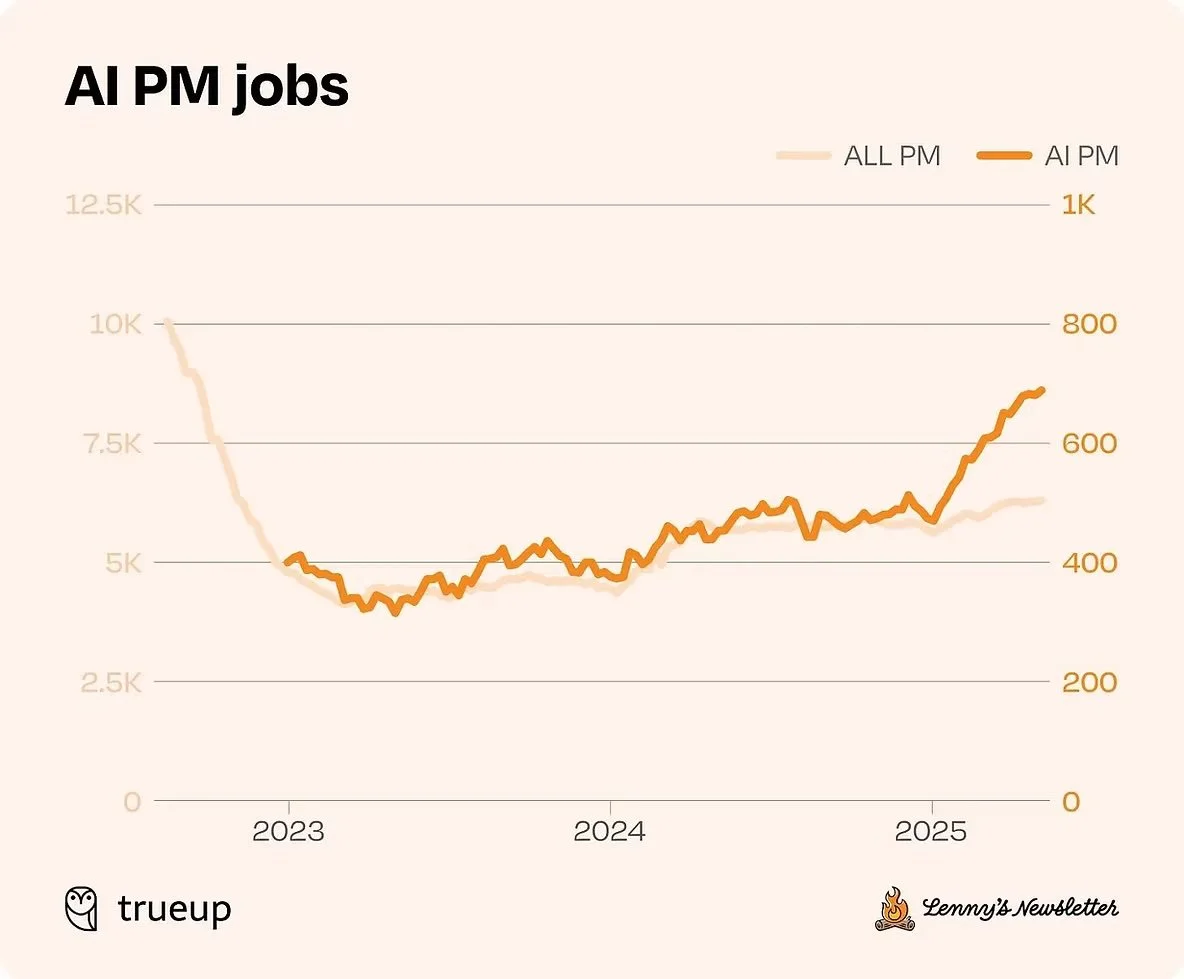Why PMs Who Don’t master AI Will Be Left Behind – and What to Learn First
The question I get the most form people I work with through interviews or career coaching is "what skill should I get that would prove most valuable". And while a year or two ago the answer would have been nuanced depending on the person now the answer is AI. Understanding the fundamentals and how to leverage it in building products has become table stakes for all PMs (and not only), who want to enter the market or stay competitive.
Picture taken from Lenny's Newsletter clearly showcases that AI skills for PM are now table stakes.
1 The day the roadmap changed
Sofia had ten years of product victories behind her—two SaaS launches, a promotion track that looked early‑retirement‑friendly, and a reputation for “shipping on time, every time.” Then, in February 2024, her CEO forwarded a competitor’s release: an AI copilot that halved onboarding time. Customer churn inside Sofia’s product spiked within a single quarter. In Q3 she lost a head‑count requisition to an internal initiative “exploring generative workflows.” By Christmas the company announced an AI‑first strategy. Sofia knew every analytics funnel by heart, yet she suddenly felt like a tourist in her own organization.
Sofia’s story is not an anecdote; it is fast becoming the median experience. Gartner now predicts that 70 % of net‑new software features released in 2026 will leverage generative AI. Board decks cite OpenAI, Anthropic and Mistral as often as AWS or Adobe. Recruiters flag “LLM experience” next to “Agile certification.”
The message is clear: AI literacy is no longer a differentiator— it is table stakes.
2 Why the stakes are higher than mobile or cloud
Platform shifts repeat a familiar arc: scepticism → novelty demos → must‑have capability. Yet generative AI accelerates that arc because it touches decision‑making itself. Smartphones expanded access; the cloud expanded elasticity; AI expands cognition. A non‑AI feature is not merely “less convenient”—it now feels intellectually inert. Users compare every writing field to Notion AI, every spreadsheet cell to Copilot. If your product answers in static text while a rival reasons in context, the user is gone before the A/B completes.
At the company level, two macro forces are colliding:
Economic leverage – McKinsey’s December 2024 report found teams integrating LLM copilots delivered features with 37 % fewer engineering hours on average. A PM who cannot deliver similar leverage becomes financially unattractive.
Cultural gravity – AI tools seep into daily workflows—code diff explanations in GitHub, auto‑generated product briefs in Google Docs, slide decks drafted by ChatGPT. The PM who resists that tide appears obstructionist, not cautious.
History suggests the market punishes laggards. Nokia missed touchscreen UX, Blackberry missed app ecosystems, and both fell within five‑year windows. AI is moving faster.
3 What “AI‑literate” really means for PMs
AI literacy is not the ability to train a 70‑billion‑parameter model. It is the disciplined fluency in four domains:
Conceptual understanding – Knowing how transformers, embeddings and diffusion models work well enough to reason about capability, latency and cost trade‑offs.
Product orchestration – Designing feature flows that combine an LLM core with retrieval, tool‑calling and guardrails—then framing requirements that engineers, designers and data scientists can all act upon.
Evaluation & governance – Defining what “good” means when output is probabilistic: building golden datasets, hallucination tests, red‑team prompts and cost dashboards.
Strategic storytelling – Explaining to executives and customers why AI features tie directly to outcomes (conversion, retention, margin) rather than novelty.
The PM who commands these four pillars directs the conversation. The PM who does not becomes a backlog administrator waiting for technical leadership to decide.
4 The personal productivity delta
Individual PMs already wield AI as a secret‑sauce co‑pilot:
Research synthesis – Feed 30 interview transcripts to GPT‑4 and ask for themes mapped to Jobs‑to‑Be‑Done; hours collapse to minutes.
Competitive analysis – Prompt Claude 3 for a SWOT on the top five payroll startups; receive a first draft that—while imperfect—jumps you 70 % up the hill.
PRD bootstrapping – Ask Gemini Pro to structure a requirements doc with goals, metrics, edge cases and open questions; you refine instead of invent.
Skeptics shrug at “AI first drafts,” yet those first drafts shift the baseline velocity. When every adjacent PM produces five strategic options before lunch, the one who types from scratch is already behind.
5 The career calculus—risk and upside
Recruiters already filter resumes for “built with LLMs.” Compensation surveys show +12 % median salary bump for AI‑literate PMs in North America. Conversely, internal mobility data from multiple Fortune 500s reveals that PMs who avoided AI projects in 2024 are 40 % less likely to lead a new‑initiative squad in 2025.
The upside is not only monetary. PMs who master AI report greater strategic influence—because they translate amorphous executive mandates (“We need something with AI”) into concrete roadmaps. Influence compounds.
Conclusion: your next step, today
The window between curiosity and irrelevance is narrowing. You do not need to be a machine‑learning engineer, but you must learn the language, the constraints, and the levers of generative AI. Spend an evening in the API playground. Build a golden eval set.
The PM era of deterministic wireframes is fading. The era of curating adaptive intelligence has begun. Choose to learn, and you ride the wave. Choose to wait, and the wave rides over you.
Start now. Your future roadmap—and your future relevance—depend on it.
Link to Lenny's full article: https://www.lennysnewsletter.com/p/state-of-the-product-job-market-in

